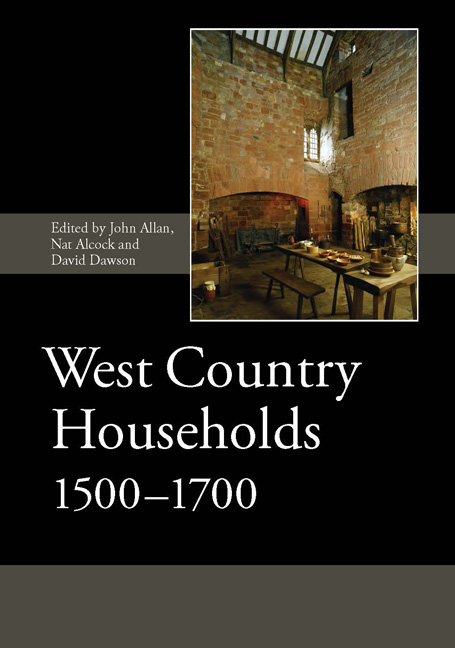Book contents
- Frontmatter
- Dedication
- Contents
- List of Illustrations
- List of Contributors
- List of Abbreviations
- Introduction
- I The Form and Development of West Country Houses
- 1 The Development of the Vernacular House in South-West England, 1500–1700
- 2 The Transformation of the Building Stock of Exeter, 1450–1700
- 3 The Appearances of Godolphin, Cornwall, c. 1300–c. 1630
- 4 Boiling Furnaces, Smoking Chambers and Malt Kilns in West Country Households
- II The Decoration of West Country Houses
- III The Material Culture of West Country Households
- Index of People and Places
- Index of Subjects
4 - Boiling Furnaces, Smoking Chambers and Malt Kilns in West Country Households
from I - The Form and Development of West Country Houses
Published online by Cambridge University Press: 05 May 2015
- Frontmatter
- Dedication
- Contents
- List of Illustrations
- List of Contributors
- List of Abbreviations
- Introduction
- I The Form and Development of West Country Houses
- 1 The Development of the Vernacular House in South-West England, 1500–1700
- 2 The Transformation of the Building Stock of Exeter, 1450–1700
- 3 The Appearances of Godolphin, Cornwall, c. 1300–c. 1630
- 4 Boiling Furnaces, Smoking Chambers and Malt Kilns in West Country Households
- II The Decoration of West Country Houses
- III The Material Culture of West Country Households
- Index of People and Places
- Index of Subjects
Summary
Physical evidence for various forms of structure associated with the kitchen fireplace is widespread in West Country houses. Consideration of contemporary documentation of domestic processes, alongside practical working knowledge of the kitchen, has led the writer to the conclusion that these features have commonly been misinterpreted in the past. Evidence for the use of the furnace is described, and it is concluded that the type of structure previously regarded as a bacon-curing chamber is in fact a malting kiln.
INTRODUCTION
Over the past 40 years the study of the vernacular kitchen fireplace and its appurtenances in the South-West has produced a number of well-observed and pioneering papers. Written by fieldworkers in vernacular architecture, they have made valuable contributions to an understanding of the subject by searching out a variety of structural features associated with the fireplace and by publishing excellent descriptions, measured drawings and photographs of them. Their work has provided an established nomenclature for these features and led to widely held beliefs about their functions.
The present paper challenges some of the fundamental conclusions arising from this body of work. unlike all the earlier studies, whose conclusions have been drawn mainly from survey of surviving structures, it considers the physical evidence alongside that drawn from contemporary documentation of domestic processes, combined with practical working knowledge.
BOILING FOOD, BREWING LIQUORS AND LAUNDRY
Simmering food in a ceramic or metal pot held over a fire on short legs, on a brandreth or from a pot-hanger, is a wasteful process: most of the heat simply rushes past the cooking vessel and is lost in the air above. The construction of a furnace – a mass of clay or masonry enclosing the pot to within a few centimetres of its surface – provided a more efficient means of achieving the same end. Structures of this type provided hot water not only for boiling joints of salt meat, puddings, etc., but for brewing and laundry.
- Type
- Chapter
- Information
- West Country Households, 1500–1700 , pp. 99 - 114Publisher: Boydell & BrewerPrint publication year: 2015



